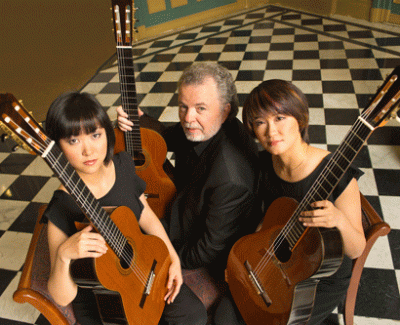Manuel Barrueco and the Beijing Guitar Duo in Review
MetLife Foundation Music of the Americas Concert Series, 2017 New York Guitar Seminar at Mannes: Manuel Barrueco and the Beijing Guitar Duo
Manuel Barrueco, guitar, and the Beijing Guitar Duo: Meng Su and Yameng Wang, guitar
The Americas Society, New York, NY
June 26, 2017
Kicking off the 2017 New York Guitar Seminar at Mannes was an absolutely superb concert by an esteemed master of the instrument, Manuel Barrueco and two extraordinary young stars, Meng Su and Yameng Wang of the Beijing Guitar Duo. Mr. Barrueco hardly needs introduction, having been a leader in the guitar world for several decades. After emigrating to the US from Cuba to train at the Peabody Conservatory, his career took off, and he now maintains his own small Peabody studio. The Beijing Duo members, counted among his protégés, are much more than protegés, as both are masters in their own right with very busy careers underway. Meng Su was winner of the Vienna Youth Guitar Competition and the Christopher Parkening Young Guitarist Competition, and Yameng Wang was the youngest guitarist in history to win the Tokyo International Guitar Competition at age 12 and was invited by Radio France to perform at the Paris International Guitar Week at age 14. They both perform actively across the globe. As a duo, Su and Wang play with consummate sensitivity, as if playing a single instrument. In Barrueco’s collaboration with them, one heard the sublime melding of his lifetime of musical experience with their split-second responsiveness and keen musical instincts. What a trio!
The program was divided between Bach on the first half and Enrique Granados on the second – not a huge surprise given that works from the Baroque and Spanish repertoires are mainstays for the guitar. On the first half, we heard Bach’s Brandenburg Concerto No. 6 arranged for all three guitars and then the Chaconne in D minor from the Partita No. 2 for violin, BWV 1004, as arranged and performed on solo guitar by Mr. Barrueco.
Various transcriptions of the Brandenburg Concerti exist for nearly every kind of ensemble, including, of course, multiple guitars. As a devotee of these works in something close to their original instrumentation, I found their invigorating performance a surprise and delight. It was captivating. Because the arranger was not named in the program, one might be hard pressed to figure out whether the success was due more to the arrangement or to the performance – most likely there was a debt to both.
Despite the blending of similar timbres from three guitars, there was a clarity of voicing and distinctness of entrances that brought this work to buoyant heights. Highlights included the exquisite end to the brief Adagio movement, where ensemble work was about as close to perfection as it can ever be, and the extremely light finale, liberated from the less flexible weightiness that can beset larger ensembles. It enjoyed a breathtaking balance between individual expressiveness and group momentum. I won’t soon forget the first entrance of the finale’s sixteenth-note motive being tossed between guitars – it was pure life-affirming joy.
About the second work, I’ll confess that as soon as I saw a solo guitar arrangement of Bach’s famous Chaconne in D minor on the program, I had some trepidation. Despite popular opinion, most reviewers do not enjoy being a “wet blanket,” but this reviewer has long had serious misgivings about the effectiveness of this piece for solo guitar, even in the most masterful hands. There is simply something about the grandeur and passion of the violin’s sustained legato lines, the strenuous double and triple stops and heightened resonance, that is perfectly suited to the cathedral-like architecture of this piece (with Busoni’s arrangement for piano coming in perhaps as close second); despite the powerful original (or because of it), guitarists have not been able to resist this Everest, including, among past artists, the noble Segovia. Anyway, with that disclosure behind us, one can say that Mr. Barrueco’s version is surely among the best for his instrument, and his performance was indeed thoroughly engaging. He is undoubtedly still on top of his game, with enormous artistry and virtuosity to share.
The second half opened with the Valses Poeticos of Granados, played by the Beijing Guitar Duo. Extremely well suited to their sensitive listening and flexible team work, this arrangement from the original piano version (arranger not listed) came off beautifully. It was richly fulfilling to hear the exchange of lines from one guitar to the other, with intimate expressiveness, and also to behold the inspired moments when they were breathing musically as one player. No nuance was beyond their conception. Bravissima!
The biggest thrills of the evening, though, were in the performances of all three guitarists, mentor and “protégés.” The selections from Goyescas were enchanting. Again, we had the energy and flexibility of youth combining with a musical savoir faire that has spanned generations. This is not to suggest, by the way, that the younger players are in any way missing their own musical savoir faire – the rubato in melodies traded between Ms. Su and Ms. Wang had all the heart and soul of old Spain. Though all seven movements were listed, only three were performed, El Pelele (“The Puppet” or “The Strawman” by some translations), The Maiden and the Nightingale, and El Fandango de Candil to finish. Each was alive with musical color, and each was played with the highest polish. It was an excellent finale to a superb concert.
For encores the lucky and enthusiastic audience members (including many guitar aficionados) were treated to a Danza by Cervantes from Mr. Barrueco’s native Cuba, and a crowd-pleasing encore (name not quite heard) from China, the land of the Beijing Duo. Congratulations are due to these exceptional performers and to the NY Guitar Seminar for a strong start to their series.

